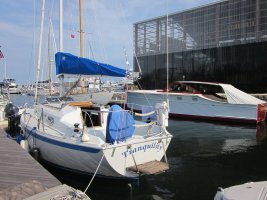Hi Seth,
Thanks for your reply. Yes, I understand the backstay not going as high on the E30+, and I do find the backstay adjuster to make a difference when the wind pipes up. But my 1984 E30+ has the cap shrouds, intermediate and lower shroud, rather than the lower forward and aft shrouds. The one page rig tuning section from the E30+ manual advises no mast rake on the E30+, and doesn't address mast bend, which I found a bit unusual. At this point I have no mast bend, and the shrouds all tuned tight enough that there is no slack when the boat is heeled about 20 degrees in about 18 knot winds, with the cap shroud the tightest (I think at about 12% breaking strength), the lowers about the same and the intermediate a little bit less. The mast appears straight, both by sight up the mast track and by halyard measurement at the dock, and does not bend to leeward when I sight up the mast under sail. The furling headsail/headstay has about 6 - 8 inches sag in it. I would prefer to tighten this a bit more, but I have adjusted it as tight as it will go on the Harken furler and don't want to re-cut at this time. I have slight weather helm in higher breezes, but never alot of pressure on the wheel--at most the steering wheel is turned one quarter of one turn to counteract weatherhelm, and it can turn two full turns side to side in its full range from rudder stop to other rudder stop. When I turn the rudder that quarter turn at the dock, I can see that the rudder is turned just slightly from centre--maybe about 5 degrees, though it's hard to eyeball.
I can easily get the boat to 6 knots in about 15 - 20 knots wind, and on a relatively flat/low waves day, I have achieved 7.8 knots. I reef the main at about 18 knots and a 2nd reef at about 23 knots, to keep her on her feet and not heeled too far. Any other suggestions to help her sail to her potential? I am familiar with outhaul, boom vang, traveller, cunningham adjustments.
Thanks for any extra tips. In general, I am very pleased with how our boat sails, but always looking for ways to get that extra 1/10th of a knot!
Frank



